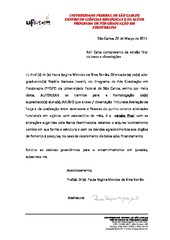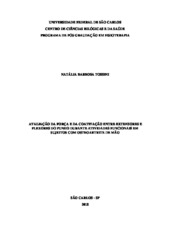| dc.contributor.author | Tossini, Natália Barbosa | |
| dc.date.accessioned | 2018-05-14T12:38:17Z | |
| dc.date.available | 2018-05-14T12:38:17Z | |
| dc.date.issued | 2018-02-26 | |
| dc.identifier.citation | TOSSINI, Natália Barbosa. Avaliação da força e da coativação entre extensores e flexores do punho durante atividades funcionais em sujeitos com osteoartrite de mão. 2018. Dissertação (Mestrado em Fisioterapia) – Universidade Federal de São Carlos, São Carlos, 2018. Disponível em: https://repositorio.ufscar.br/handle/ufscar/9980. | * |
| dc.identifier.uri | https://repositorio.ufscar.br/handle/ufscar/9980 | |
| dc.description.abstract | Introduction: Grip strength in subjects with hand osteoarthritis (OA) is lower when compared to healthy individuals. However, to date, grip strength has been assessed only in subjects with advanced OAM. In addition, during activities involving the use of pinch and/or the grip of objects, it is necessary that the wrist extensor muscles act to stabilize this joint, and no study has evaluated this muscle group in subjects with OAM in the early stages of the disease. Objectives: The objective of this dissertation was to evaluate the maximum grip strength, self-reported function, magnitude of activation and coactivation between the extensor and flexor muscles of the wrist in subjects with initial degrees of OAM and to compare with healthy subjects. In addition, it was aimed correlate grip strength and flexor and extensor strength of the wrist with the self-reported function, pain and stiffness in subjects with OAM in the early stages of the disease. Methods: 32 subjects, divided into two groups: GC (n = 16, 55±7,42, healthy subjects) and GOAM (n = 16, 57±7,82, subjects with hand OA, grades II and III) participated in this study. All participants responded to an initial assessment form and the Australian / Canadian Hand Osteoarthritis Index (AUSCAN) and Disabilities of the Arm, Shoulder, and Hand (DASH) questionnaires. After that, evaluation of the grip strength and the flexor and extensor isometric flexor torque were performed. The electrical signal evaluation of ulnar flexor carpi ulnaris (FCU), flexor digitorum superficialis (FDS) and extensor (EXT) muscles was performed during functional activities (cutting with scissors, writing and opening and closing a bottle), and concomitant with the grip test. The groups were compared using the Student's t-test for independent samples or Mann-Whitney. Also, the Person's correlation was applied to the variables of interest (p≤0.05). Results: For the mean activation of the flexor and extensor muscles of the wrist, there was a lower muscular activation in GOAM in all activities performed, with statistical difference for FDS (p = 0.01) and EXT (p = 0.04) in scissors task and FCU in the task of the bottle (p = 0,05). No difference was found between the groups for the index of coactivation nor for the grip strength. A moderate and negative correlation was found between the grip strength and the DASH questionnaire (r =-0.59, p = 0.01), as well with the AUSCAN questionnaire (r =-0.66, p≤0, 01). No correlations were found between the flexor and extensor isometric torques with the questionnaires. Conclusion: People with hand OA, already in the early stages of the disease, have less activation of the wrist muscles during the execution of some functional tasks, which may be related to a muscle inhibition. In addition, at the beginning of the disease grip strength correlates with functional alterations, pain and self-reported stiffness. | eng |
| dc.description.sponsorship | Coordenação de Aperfeiçoamento de Pessoal de Nível Superior (CAPES) | por |
| dc.language.iso | por | por |
| dc.publisher | Universidade Federal de São Carlos | por |
| dc.rights.uri | Acesso aberto | por |
| dc.subject | Osteoartrite de mão | por |
| dc.subject | Força de preensão | por |
| dc.subject | Ativação muscular | por |
| dc.subject | Torque | por |
| dc.subject | Dor | por |
| dc.subject | Hand osteoarthritis | eng |
| dc.subject | Grip strength | eng |
| dc.subject | Muscle activation | eng |
| dc.subject | Pain | eng |
| dc.title | Avaliação da força e da coativação entre extensores e flexores do punho durante atividades funcionais em sujeitos com osteoartrite de mão | por |
| dc.type | Dissertação | por |
| dc.contributor.advisor1 | Serrão, Paula Regina Mendes da Silva | |
| dc.contributor.advisor1Lattes | http://lattes.cnpq.br/2917658715637353 | por |
| dc.description.resumo | Introdução: A força de preensão palmar em sujeitos com osteoartrite na mão (OAM) é menor quando comparada a indivíduos saudáveis. No entanto, até o momento, a força de preensão palmar foi avaliada apenas em sujeitos com OAM avançada. Além disso, durante atividades que envolvam a utilização da pinça e/ou a preensão de objetos, é necessário que os músculos extensores do punho atuem para estabilizar essa articulação, e nenhum estudo avaliou esse grupo muscular em sujeitos com OAM nos graus iniciais da doença. Objetivos: O objetivo desta dissertação foi avaliar a força máxima de preensão palmar, a função autorrelatada, a magnitude de ativação e a coativação entre os músculos extensores e flexores do punho de sujeitos com graus iniciais de OAM e comparar com sujeitos saudáveis. Além disso, foi objetivo correlacionar a força de preensão palmar e a força de flexores e extensores do punho com a função autorrelatada, a dor e a rigidez de sujeitos com OAM nos graus iniciais da doença. Métodos: Participaram deste estudo 32 sujeitos, divididos em 2 grupos: GC (n=16, 55±7,42, sujeitos saudáveis) e GOAM (n=16, 57±7,82, com diagnóstico de OAM, graus II e III). Todos os participantes foram avaliados inicialmente e responderam aos questionários Australian/Canadian Hand Osteoarthritis Index (AUSCAN) e Disabilities of the Arm, Shoulder, and Hand (DASH). Após isso, foi realizada avaliação da força de preensão palmar e do torque isométrico flexor e extensor do punho. A avaliação da atividade elétrica dos músculos flexor ulnar do carpo (FUC), flexor superficial dos dedos (FSD) e extensores (EXT) foi realizado durante a realização de atividades funcionais (cortar com uma tesoura, escrever e abrir e fechar uma garrafa), e concomitante ao teste de preensão palmar. Os grupos foram comparados por meio do teste t-Student para amostras independentes ou Mann-Whitney. Também foi aplicado a correlação de Person para as variáveis de interesse (p≤0,05). Resultados: Para a média de ativação dos músculos flexores e extensores do punho foi encontrada menor ativação muscular no GOAM em todas as atividades realizadas, com diferença estatística para o FSD (p=0,01) e EXT (p=0,04) na tarefa da tesoura e FUC na tarefa da garrafa (p=0,05). Não foi encontrado diferença entre os grupos para o índice de coativação e nem para a força de preensão palmar. Foi encontrado correlação moderada e negativa entre a força de preensão palmar e o questionário DASH (r=-0,59; p = 0,01), bem como com o questionário AUSCAN (r=-0,66; p≤0,01). Não foram encontradas correlações entre os torques isométricos flexores e extensores com os questionários. Conclusão: Sujeitos com OAM, já nos graus iniciais da doença, apresentam menor ativação dos músculos do punho durante a execução de algumas tarefas funcionais, podendo esse estar relacionado à uma inibição muscular, decorrente da doença. Além disso, já no início da OAM a força de preensão palmar se correlaciona com as alterações funcionais, dor e rigidez autorrrelatadas. | por |
| dc.publisher.initials | UFSCar | por |
| dc.publisher.program | Programa de Pós-Graduação em Fisioterapia - PPGFt | por |
| dc.subject.cnpq | CIENCIAS BIOLOGICAS::FISIOLOGIA::FISIOLOGIA DE ORGAOS E SISTEMAS::CINESIOLOGIA | por |
| dc.ufscar.embargo | Online | por |
| dc.publisher.address | Câmpus São Carlos | por |
| dc.contributor.authorlattes | http://lattes.cnpq.br/8249155488364410 | por |

